2008 Jeep Grand Cherokee Limited CRD 4×4 Review
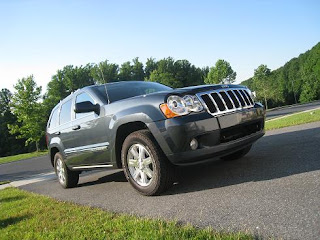 The new US CAFE (fuel economy) rules will force every automobile manufacturer to re-think its product portfolio over the next few years to focus more on efficiency and less on performance. We’re going to see more widespread application of technology that is sometimes more costly such as direct injection, hybrids, lightweight materials, and turbocharging. Another solution to improving our auto fleet’s average mileage is the diesel engine, which generally improves fuel efficiency by about 20 to 25% over a comparable gasoline engine.
The new US CAFE (fuel economy) rules will force every automobile manufacturer to re-think its product portfolio over the next few years to focus more on efficiency and less on performance. We’re going to see more widespread application of technology that is sometimes more costly such as direct injection, hybrids, lightweight materials, and turbocharging. Another solution to improving our auto fleet’s average mileage is the diesel engine, which generally improves fuel efficiency by about 20 to 25% over a comparable gasoline engine.
I wrote nearly a year ago about the “diesel invasion” that was coming, and one of the early diesels to be sold on a non-commercial vehicle is the new-for-2008 Jeep Grand Cherokee CRD. CRD stands for common-rail diesel; without going into the gory technical details, just know that it’s not anything like a 1980-vintage Oldsmobile diesel. It even literally takes a different kind of diesel fuel than the 1980s GMs did (ultra low sulfur diesel fuel, which doesn’t even smell like diesel fuel of yore).
I was very excited when I learned that I’d be testing the Grand Cherokee CRD for several days; the Grand Cherokee is by far my favorite Jeep, in terms of size, packaging, and styling. Coupled with a new 3.0 liter diesel engine and five speed automatic sourced from Chrysler’s former Mercedes overlords, the Jeep made for a compelling vehicle to test.
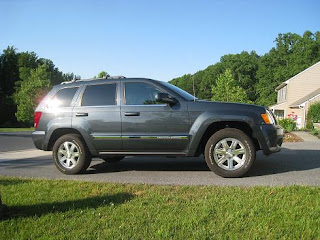 The Grand Cherokee’s shape certainly evokes images of a rugged vehicle capable of conquering any off road trail. The shape can be described as more boxy than curvaceous, although curves can be found in the hoodline around the headlights as well as the large fender bulges – which, thankfully, are part of the sheet metal and not tacked on the way they are in the Jeep Commander. The Grand Cherokee, like previous generations of the same vehicle, has a very steeply-raked windshield for such an otherwise mostly squared-off vehicle (contrast that with the nearly-upright Wrangler windshield), but it doubtless helps wind noise and fuel efficiency at least a little bit. The 17 inch wheels look a little small in the large wheel openings, but much larger diameter wheels probably wouldn’t be “Trail Rated,” and the 17 inchers also allow plenty of room for suspension travel off road. Not that I’d know from experience, however, since the furthest off road I took it was onto a gravel parking lot, in spite of my best efforts to visit a friend’s cabin in the woods. I’m also a fan of tasteful chrome adornments, and the Grand Cherokee Limited has horizontal chrome strips across the rear bumper, along the door moldings, and below the side windows, plus a chrome grille. The Steel Blue Metallic exterior color looked tasteful yet rugged. Really, I had no complaints about the Grand Cherokee’s looks. It’s the Baby Bear of Jeeps – not too big (Commander), not too small (Liberty, Patriot), not too car-like (Compass), not too truck-like (Wrangler). It’s just right.
The Grand Cherokee’s shape certainly evokes images of a rugged vehicle capable of conquering any off road trail. The shape can be described as more boxy than curvaceous, although curves can be found in the hoodline around the headlights as well as the large fender bulges – which, thankfully, are part of the sheet metal and not tacked on the way they are in the Jeep Commander. The Grand Cherokee, like previous generations of the same vehicle, has a very steeply-raked windshield for such an otherwise mostly squared-off vehicle (contrast that with the nearly-upright Wrangler windshield), but it doubtless helps wind noise and fuel efficiency at least a little bit. The 17 inch wheels look a little small in the large wheel openings, but much larger diameter wheels probably wouldn’t be “Trail Rated,” and the 17 inchers also allow plenty of room for suspension travel off road. Not that I’d know from experience, however, since the furthest off road I took it was onto a gravel parking lot, in spite of my best efforts to visit a friend’s cabin in the woods. I’m also a fan of tasteful chrome adornments, and the Grand Cherokee Limited has horizontal chrome strips across the rear bumper, along the door moldings, and below the side windows, plus a chrome grille. The Steel Blue Metallic exterior color looked tasteful yet rugged. Really, I had no complaints about the Grand Cherokee’s looks. It’s the Baby Bear of Jeeps – not too big (Commander), not too small (Liberty, Patriot), not too car-like (Compass), not too truck-like (Wrangler). It’s just right.
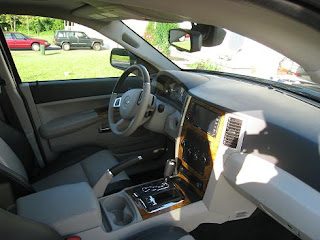 Inside, the interior design was very attractive. Unlike with many Chrysler vehicles, the squared-off look (plus a few select gentle curves) actually works very well with the Grand Cherokee, since the outside shape more or less follows the same theme. My Limited test vehicle had two-tone leather seats (Dark Slate Gray/Light Sandstone) with door panels and dashboard trim in identical colors. The front door panels and center stack are adorned with faux wood, but it (along with a few chrome accents here and there) help spruce up an otherwise plastic-heavy workplace. I was disappointed to notice that, like the Town & Country minivan, the entire dashboard is made of hard, hollow plastic. In contrast, the 300C AWD had a soft-touch dashboard that felt like it was made of a higher-grade material. I was hoping for something better than hard plastic in a $43,605 vehicle.
Inside, the interior design was very attractive. Unlike with many Chrysler vehicles, the squared-off look (plus a few select gentle curves) actually works very well with the Grand Cherokee, since the outside shape more or less follows the same theme. My Limited test vehicle had two-tone leather seats (Dark Slate Gray/Light Sandstone) with door panels and dashboard trim in identical colors. The front door panels and center stack are adorned with faux wood, but it (along with a few chrome accents here and there) help spruce up an otherwise plastic-heavy workplace. I was disappointed to notice that, like the Town & Country minivan, the entire dashboard is made of hard, hollow plastic. In contrast, the 300C AWD had a soft-touch dashboard that felt like it was made of a higher-grade material. I was hoping for something better than hard plastic in a $43,605 vehicle.
Interior features, however, were abundant in my loaded tester. It included navigation, MyGIG hard disc, heated front and rear seats, and Sirius Satellite Radio. The steering wheel was also one of my favorites in a Chrysler vehicle, as it was nice and thick and carried the same two-tone motif as the rest of the interior, with plastic chrome rings bisecting the dark and light segments of the rim.
Really, my only criticism of the interior other than the hard plastic dash is that it’s a bit cramped, particularly aft of the front seats. The rear seat does not have much legroom, which was illustrated by the difficulty I had in securing a rear-facing convertible car seat (that’s generally my ultimate test for the amount of space in the back seat of a test vehicle). We did manage to fit the seat into the Jeep, but it was closer to the front seat than we would have preferred; I’d say that rear seat legroom was similar to the 2009 Corolla that I tested last month. Also, the cargo area was very high and shallow. It’s a high lift for loading cargo, and don’t expect to carry anything tall in the cargo area.
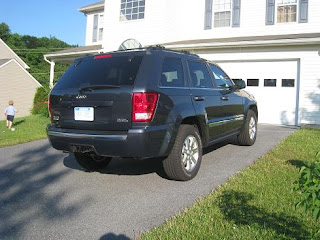 As noted earlier, I was more excited to experience a modern turbodiesel than anything else when testing the Jeep. The first thing I noticed was a lack of odor while the engine idled. Bravely sticking my nose an inch from the tailpipe while it idled, I couldn’t smell any telltale diesel odors. I also never saw smoke coming from the exhaust pipe, although I obviously never followed myself to see if hard acceleration was enough to unleash smoke. However, the exhaust system really seemed to get HOT on this thing. One morning, I was stopped at a red light, and I noticed some smoke wafting past my passenger side (the side the exhaust pipe is on). A fellow motorist looked at me with a concerned look, but the gauges all looked good and I didn’t see anything too alarming, so I drove the last mile to my parking garage. I investigated the underside of the truck, and it smelled pretty hot, but there was no smoke coming out. The test truck only had about 2,200 miles on it, so perhaps it still wasn’t fully broken in. I did not experience any repeats of this phenomenon, but I had not been driving the Jeep hard prior to the smoke episode.
As noted earlier, I was more excited to experience a modern turbodiesel than anything else when testing the Jeep. The first thing I noticed was a lack of odor while the engine idled. Bravely sticking my nose an inch from the tailpipe while it idled, I couldn’t smell any telltale diesel odors. I also never saw smoke coming from the exhaust pipe, although I obviously never followed myself to see if hard acceleration was enough to unleash smoke. However, the exhaust system really seemed to get HOT on this thing. One morning, I was stopped at a red light, and I noticed some smoke wafting past my passenger side (the side the exhaust pipe is on). A fellow motorist looked at me with a concerned look, but the gauges all looked good and I didn’t see anything too alarming, so I drove the last mile to my parking garage. I investigated the underside of the truck, and it smelled pretty hot, but there was no smoke coming out. The test truck only had about 2,200 miles on it, so perhaps it still wasn’t fully broken in. I did not experience any repeats of this phenomenon, but I had not been driving the Jeep hard prior to the smoke episode.
Starting the Grand Cherokee CRD is very similar to starting any other Chrysler vehicle. The “smart key” is basically a plastic key that you dock into the dash, and turn like a conventional key. You merely have to turn the key to the “start” position and release, and the engine will crank until it starts. Although the owner’s manual mentioned glow plugs (which in my childhood in the 1980s with a handful of Oldsmobile diesels meant that you’d have to turn the key to “on” for 10-15 seconds before turning the engine over), I didn’t see any lights or such indicating that they were needed. The engine started nearly as quickly as a gasoline-powered vehicle and settled into a smooth idle around 600 RPMs. Minor clatter is audible under the hood, but nothing from the exhaust end. Revving the engine gives a little bit of a diesel sound, but it’s still very smooth and quiet at idle.
My wife said that she didn’t like the diesel sounds and that she perceived it as noisier than a gasoline engine, but perhaps partially because I thought it was “cool” to have a diesel, and partially because it is SO much more refined than a 20 year old diesel, it didn’t bother me at all. At highway speeds, it felt just like a gasoline engine (and road/wind/radio noise, while not excessive, drown out any remaining diesel clatter). The Grand Cherokee was a little bouncy at highway speeds (likely due to its short off road-friendly wheelbase), but it is a very capable off roader, so I can easily forgive that. Rack and pinion steering felt accurate, and the wheel felt good in my hands.
Setting off from a stop, it feels slow for a second until the turbo spools up, then it takes off and actually pins you back into your seat. The Mercedes-sourced five-speed auto shifts quickly and always seemed to be in the right gear. Redline is just 4500 RPMs, but it’s just a small perception adjustment to know you’re getting your grunt down low instead of up high in the engine’s powerband. Speaking of powerbands, the 3.0 liter turbodiesel V6 is rated at 215 horsepower and 375 lb-ft of torque. The torque peak is reached at a low 1600-2800 RPMs. The 5.7 liter HEMI V8, in contrast, is rated at 330 horsepower and the same 375 lb-ft of torque, but the HEMI reaches its torque peak at 4,000 RPMs. While I haven’t driven a HEMI Grand Cherokee, I have spent time with the aforementioned 300C AWD, and can attest to the HEMI’s low-end torque and midrange horsepower. The diesel was a totally different animal; the low torque peak throws you into your seat after the turbo lag ends, but if you want to pass somebody at highway speeds, you have to plan very far ahead, because it has nothing to give its driver in those situations. The upshot of the diesel, however, is that the Jeep can climb very steep hills (paved or unpaved) literally without even trying. It doesn’t even have to downshift; steady application of the throttle up steep hills results in almost no change in velocity – it just keeps chugging along.
The steering ratio is fairly slow, likely another concession to off road competence (making it easier for the driver to be very accurate with steering inputs at slow speeds without fear of turning the wrong direction). The Goodyear Fortera tires didn’t have an extremely aggressive tread for off-road use, but had an incredible tread life rating of 540. Our old 2005 Pathfinder LE 4×4’s 265/65SR17 OEM tires had a similar tread depth but a tread life rating of 420. (I didn’t know that from memory; I had to look it up!) The long tread life rating is generally an indicator of a harder rubber compound that will last a long time but compromises cornering grip; that proved to be my experience with these tires. The brakes bit hard enough in panic stop-like situations, but the tires betrayed them. It was the same story with curves: the tires let the Jeep down a bit. At no time did I feel top-heavy or unsafe, but I often was wishing for more grip (and more high-speed horsepower).
The lack of horsepower and low-end grunt of the turbodiesel V6 did have one benefit – at the gas pump. The CRD model is the most fuel efficient Jeep; it’s rated at 17/22 or 19 combined (all fuel economy figures are for 4×4 models; add about one mpg for 4×2 models), while the 3.7 liter V6 is rated at 15/19 (17 combined), the 4.7 liter V8 is rated at 14/19 (15 combined), and the 5.7 liter HEMI V8 is rated at 13/18 (also 15 combined). In my experience, being gentle with the throttle yielded about 20-21 miles per gallon, but overall I averaged just under 18 miles per gallon. The funny thing is, the powertrain actually thrives on relatively gentle throttle application. The nature of the torque curve makes the driver want to take it easy on the throttle (especially when carrying passengers) because allowing all of the torque to do its job at once is a recipe for passenger whiplash. “Taking it easy” in the Jeep actually doesn’t make you feel like someone who’s a traffic impediment/nuisance, because of the copious torque available just above idle speeds.
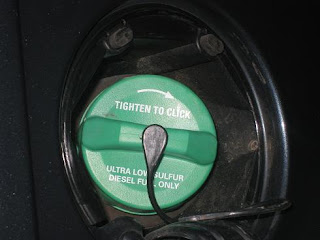 After having read stories of travails in finding ultra low-sulfur diesel fuel, I was a little worried that I wouldn’t be able to find it in my area. There is no nationwide listing of ULS diesel availability as there is for E85, and I knew better than to put the old low-sulfur diesel fuel into it (without the “ultra” tag). Fortunately, a new Shell station on my way to work did offer ULS diesel fuel, so I splashed a bit into the tank. I paid $4.849 per gallon, so for $20, I only got 4.124 gallons. (Regular 87-octane gasoline was $3.929 at the same station at that time). ULS diesel pumps can be identified by their bright green nozzles, which conveniently match the bright green fuel cap on the CRD Jeep.
After having read stories of travails in finding ultra low-sulfur diesel fuel, I was a little worried that I wouldn’t be able to find it in my area. There is no nationwide listing of ULS diesel availability as there is for E85, and I knew better than to put the old low-sulfur diesel fuel into it (without the “ultra” tag). Fortunately, a new Shell station on my way to work did offer ULS diesel fuel, so I splashed a bit into the tank. I paid $4.849 per gallon, so for $20, I only got 4.124 gallons. (Regular 87-octane gasoline was $3.929 at the same station at that time). ULS diesel pumps can be identified by their bright green nozzles, which conveniently match the bright green fuel cap on the CRD Jeep.
Jeep charges a premium of $1,655 for the 3.0 liter CRD V6 diesel option. Assuming $4.00 per gallon for regular unleaded and $5.00 per gallon for diesel fuel, the option would take over 30 years (!) To pay for itself (15,000 miles). On top of the cost being higher, the diesel sacrifices highway passing power for low-end torque and fuel economy, and that the CRD option is not available in the low-end Laredo models. If you’d like the diesel engine without the glitz of the Limited, you’re out of luck, and would end up paying thousands extra for stuff you don’t want or need. You’re also out of luck if you live in California, Connecticut, Maine, Massachusetts, New York, Pennsylvania, Rhode Island and Vermont; those eight states adhere to California’s more strict emission standards, and do not allow the Jeep to be sold new to customers residing in them. (It’s a so-called “42 state diesel,” and since I reside in Pennsylvania, I’d be in the “out of luck” category.)
If I were in the market for a midsize, off road-capable vehicle with a splash of luxury, I’d seriously consider a Grand Cherokee. Rebates are very rich as SUVs have fallen out of favor and there are deals to be made for any buyers brave enough to wade into this segment. I’m not saying that these will be collector-worthy in 30 years, but I see a lot of parallels between the incredible deals on SUVs to the great deals and depressed trade-in values of gas-guzzling muscle cars in the early 1970s that later turned into cars coveted by enthusiasts. My advice: take a diesel for a spin and see if the experience is right for you. If it is, more choices are on the horizon, but if you have to have one now, you don’t have many alternatives yet.




